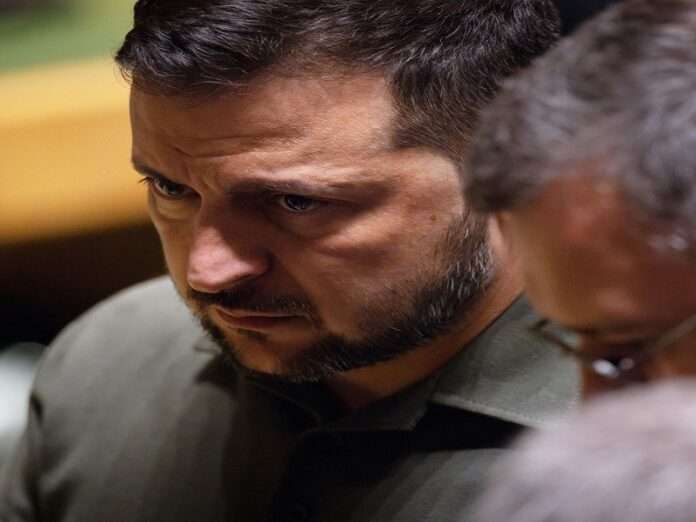Russian foreign spy chief Sergey Naryshkin released a scenario forecast on Monday after his service received reliable information “that high-ranking officials of leading Western countries are increasingly discussing among themselves the need to replace” Zelensky. Skeptics might scoff at this since his country has self-interested reasons for wanting to discredit the Ukrainian leader and widen his country’s divisions with the West, but that would be a mistake due to this actually being a credible possibility.
According to him, it’s not just Zelensky’s “endless rudeness” in dealing with his foreign partners or his “boundless nepotism and corruption” that’s driving this, but first and foremost his failure to defeat Russia on the battlefield like he promised. Seeing as how the conflict’s dynamics have recently reversed whereby Ukraine is once again on the defensive, which both Zelensky himself and his ground forces chief both recently acknowledged, there’s a need to freeze it to prevent a Russian breakthrough.
The problem is that “the head of Ukraine has gone too far in creating the image of an uncompromising supporter of a war with Moscow to a victorious end”, which precludes the possibility of him recommencing peace talks, ergo the need to swap him out for someone else who can do this instead. Naryshkin said that EU Foreign Ministers discussed this scenario last month and debated which Ukrainian figures would supposedly be best suited for playing that role.
The list includes Commander-in-Chief Zaluzhny, Chief of Staff Yermak, Kiev Mayor Klitschko, and former senior aide Arestovich, one of whom is expected to function as the “Ukrainian Pilsudski” in “creating a strong ‘cordon sanitaire’ between Russia and Europe for decades” after the conflict freezes. Naryshkin concluded by assessing that “This scenario provides for a ceasefire between Moscow and Kiev at the moment when the Ukrainian Armed Forces completely lose their offensive potential.”
While it’s impossible to independently confirm the details that he shared in his scenario forecast, the contours thereof align with the conflict’s latest trends and the West’s recalibrated interests towards it. The congressional gridlock over aid to Ukraine and that country’s return to the defensive combine with newfound political intrigue there and the West’s growing fatigue over the past 22 months to reopen the possibility for recommencing peace talks like the West has reportedly been pressuring Zelensky to do.
His latest visit to the US on Monday, which is his third since the start of the special operation, could very well result in them delivering an ultimatum to him to either comply with their demands or be replaced. The narrative stage has already been set after leading Mainstream Media outlets like the BBC, the Financial Times, Politico, the Washington Post, and others became much more critical of him since the counteroffensive failed, thus preconditioning the public to expect this scenario if it’s decided upon.
As the conflict indisputably winds down, absent some black swan event like a false flag escalation for example, it makes sense that the West would begin more seriously consider various ways to freeze it in order to prevent a full-blown Ukrainian defeat. In parallel, that New Cold War bloc would also logically want to entrench their political-military gains in that country by having it “create a strong ‘cordon sanitaire’ between Russia and Europe” similar in spirit to what the erstwhile Pilsudski sought to do.
That supplementary goal serves as yet another argument in favor of replacing him since this role could best be played by incorporating Ukraine into the Polish-led “Three Seas Initiative” (3SI). Zelensky burned all the goodwill that he used to enjoy with that country after smearing it in September, however, after accusing it during a speech at the UN of “helping set the stage to a Moscow actor”. Even though the Polish government just changed, many Poles still deeply resent Zelensky after what he said.
It would therefore be wise for the West to replace Zelensky with someone more agreeable to average Poles, which would facilitate post-conflict Ukraine’s incorporation into Poland’s 3SI. About that regional integration platform, it no longer has any chance of becoming even a semi-independent pole of influence as initially conceptualized after German-backed Tusk just returned to power in Poland. Instead, it’ll serve as yet another instrument of Germany’s envisaged hegemony over Central & Eastern Europe (CEE).
The division of labor between all of them has yet to be formalized, but the 3SI could foreseeably be leveraged by Germany to have Poland share some of the burden for reconstructing Ukraine and guiding its Euro-Atlantic path after the conflict finally freezes. Unlike before Germany’s victory over Poland in their competition for influence over that country and German-backed Tusk’s return to power, this process will be carried out under Berlin’s supervision, not independently like Warsaw initially planned.
Even though Tusk is expected to subordinate Poland to German hegemony, conservative-nationalist activists could still disrupt the Ukrainian dimension of this process, whether through another de facto blockade or through other similarly creative means. While it’s difficult to preemptively thwart such scenarios, the likelihood of them enjoying widespread support can be reduced if Zelensky’s removal leads to the meaningful improvement of Polish-Ukrainian ties at the people-to-people level.
The former Polish government with which he feuded has just been replaced, which improved that country’s standing in the eyes of many Ukrainians, so all that’s needed now is to replace Zelensky in order to complete the Polish half of this German-led reconciliation formula. If that happens, then Berlin can better manage CEE via its informal capture of the Polish-led 3SI following German-backed Tusk’s return to power in that country, and this can in turn widen its range of hegemonic options in the region.
To sum it up, the US would have to first approve the decision to replace Zelensky, which it has yet to make but appears to be seriously considering due to his refusal to recommence peace talks with Russia. If he remains recalcitrant and thus puts the West’s political-military gains in that country at risk by creating the conditions for a potential Russian breakthrough, then his political career could soon end, though it remains unclear who’ll fill his shoes in that event.
Although the US is the West’s hegemon, it’ll still probably take Germany’s preferences into consideration seeing as how Berlin just expanded its own hegemony over CEE following Tusk’s return to power, which enables Berlin to now leverage the 3SI as its own hegemonic instrument in Ukraine. The US is preparing to “Pivot (back) to Asia” despite its incipient thaw with China, hence its interest in “Leading From Behind” in Europe once the conflict freezes by having Germany take on more hegemonic responsibilities.
The stage is therefore set for Zelensky’s replacement by one of his rivals if the US decides to approve this, though it might still get cold feet even if he still refuses to recommence peace talks with Russia. Nevertheless, if he is ultimately removed, it would be because of the reasons that Naryshkin mentioned in his scenario forecast and his replacement would be whoever the West (mostly the US with some German input) has deemed to be the best fit for functioning as the “Ukrainian Pilsudski”.







